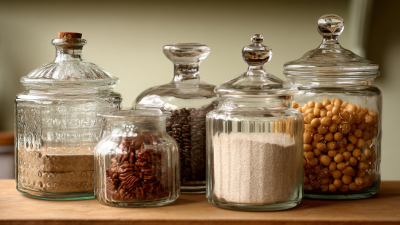
In the ever-evolving landscape of modern packaging, the emergence of Clear Glass Caps has revolutionized the way products are presented and perceived. These translucent seals not only serve a practical purpose in preserving the freshness and integrity of the contents but also bring an aesthetic elegance that captures consumer attention. This article delves into the fascinating science behind Clear Glass Caps, exploring their design innovations and the materials that contribute to their functionality.
 By examining how these caps have influenced consumer preferences and trends in the packaging industry, we uncover their broader implications on sustainability and branding. Join us as we uncover the intricate relationship between Clear Glass Caps and their impact on enhancing product visibility, appeal, and ultimately driving sales in today's competitive market.
By examining how these caps have influenced consumer preferences and trends in the packaging industry, we uncover their broader implications on sustainability and branding. Join us as we uncover the intricate relationship between Clear Glass Caps and their impact on enhancing product visibility, appeal, and ultimately driving sales in today's competitive market.
Clear glass caps are becoming increasingly prominent in the packaging industry, particularly as brands seek sustainable and eco-friendly solutions. According to a report by the Glass Packaging Institute, glass is 100% recyclable and can be recycled endlessly without any loss in quality or purity. This aligns with the growing consumer demand for sustainable packaging options, as 74% of consumers are willing to pay more for products in sustainable packaging, a trend highlighted in a 2022 Nielsen survey.
Moreover, clear glass caps not only contribute to sustainability but also enhance the aesthetic appeal of packaged products. Their transparency provides a window for consumers to see the product inside, fostering a sense of trust and transparency that is increasingly important to today's environmentally-conscious shopper. Furthermore, research indicates that glass packaging has a lower carbon footprint over its lifecycle compared to many plastic alternatives, particularly when considering the energy consumed in production and recycling. Brands integrating clear glass caps in their packaging strategies are thus not only making a statement about their commitment to the environment but also appealing to a market that values both style and sustainability.
Advancements in clear glass cap technology have revolutionized the packaging industry, enhancing not only product aesthetics but also functionality. According to a recent report from Smithers Pira, the global glass packaging market is projected to reach $70 billion by 2025, driven by innovations in design and durability. Clear glass caps, in particular, have emerged as a popular choice for premium brands seeking to differentiate their products on the shelf. With their ability to provide a complete view of the product inside, these caps create a visually appealing presentation that resonates with environmentally conscious consumers.
Furthermore, the introduction of advanced manufacturing techniques has significantly improved the production efficiency and sustainability of clear glass caps. A study by the Glass Packaging Institute revealed that advancements such as lightweighting and more efficient melting processes can reduce energy consumption by up to 30%. These innovations not only lower production costs but also contribute to reduced carbon footprints—making clear glass caps an attractive option for brands looking to improve their environmental impact while maintaining high-quality packaging standards. As these technologies evolve, the clear glass cap market is set to expand, offering even more creative possibilities for product packaging.
The global food packaging market is projected to reach a value of $81.54 billion by 2024 and is expected to grow to $85.17 billion by 2025, ultimately soaring to $122.15 billion by 2032. This impressive growth highlights a significant trend towards sustainable packaging solutions, with glass packaging gaining traction due to its premium appeal and recyclability. As consumers become more environmentally conscious, the demand for clear glass caps and other glass packaging options continues to rise, reflecting a shift towards products that combine functionality with aesthetics.
In addition to food packaging, the bottled machinery market is also on the rise, forecasting growth from $3.81 billion in 2018 to $6.31 billion by 2032, driven by a compound annual growth rate of 3.4%. This growth is indicative of the increased reliance on automated processes in the packaging industry, enabling higher efficiency and meeting the demands of a variety of consumer goods. With the trend favoring glass as a preferred material, businesses are strategically pivoting to adopt glass packaging solutions that will not only meet regulatory standards but also resonate with eco-conscious consumers.
The data illustrates the growing demand for glass packaging over the recent years, indicating a significant increase in market value from 2018 to 2023. This trend reflects the increasing consumer preference for sustainable and aesthetically appealing packaging solutions.
Clear glass caps have emerged as a game-changer in modern packaging, significantly influencing brand perception and consumer trust. According to a study by the Packaging Association, 70% of consumers associate glass packaging with higher quality and trustworthiness compared to plastic alternatives. This perception stems from the transparency and purity that glass delivers, showcasing product integrity. Brands that utilize clear glass caps often experience enhanced consumer confidence, which can directly impact purchasing decisions.
Moreover, a report by Transparency Market Research states that products packaged in glass not only help brands stand out on crowded shelves but also align with the increasing demand for sustainable packaging. With sustainability being a key concern for 54% of consumers, as highlighted by Nielsen, clear glass options offer a recyclable and eco-friendly alternative that resonates with environmentally-conscious shoppers. Brands leveraging clear glass caps can thus foster a deeper emotional connection with their audience, building trust through shared values and a commitment to reducing environmental impact.
The rise of clear glass caps in modern packaging is reshaping consumer perceptions and product presentations. According to a recent industry report by Smithers, the global market for glass packaging is expected to grow at a CAGR of 3.3%, reflecting a strong preference for sustainable materials over traditional options. Clear glass caps not only provide a sleek aesthetic but also maintain product integrity, offering superior protection against external contaminants compared to plastic alternatives. Specifically, glass has been shown to be an effective barrier against oxygen, which is vital for preserving the freshness of consumables.
In a comparative analysis of performance, a study published by Packaging Strategies reveals that clear glass caps outperform traditional plastic in terms of recyclability and durability. While plastic lids often exhibit wear and tear, leading to seal failure, glass caps maintain their integrity across multiple uses. Additionally, the report highlights that consumers are increasingly drawn to products with eco-friendly packaging, with 60% stating they would pay more for sustainable options. As brands shift towards environmentally responsible solutions, clear glass caps emerge as a compelling choice that enhances not only the product's shelf appeal but also its environmental footprint.






